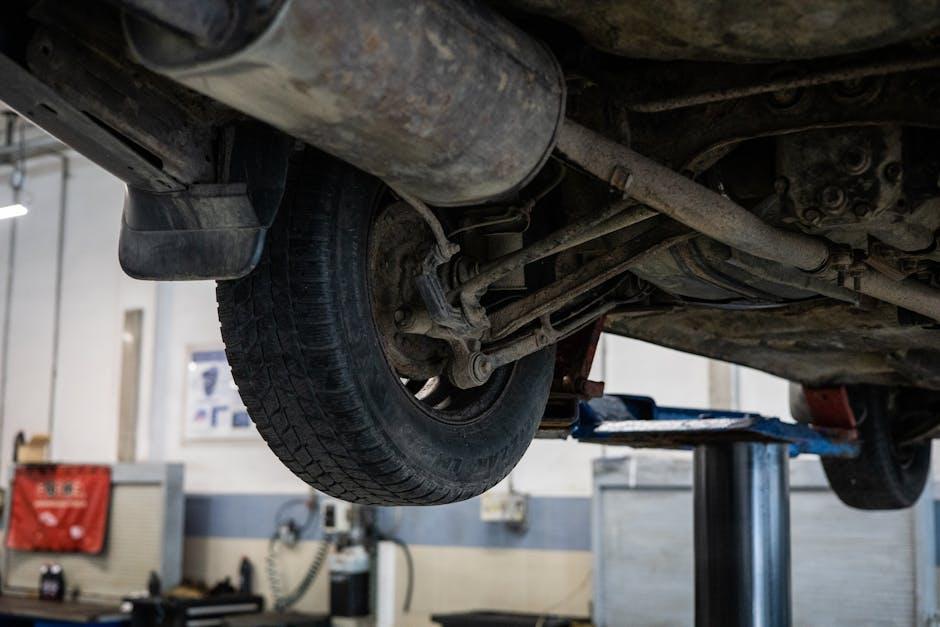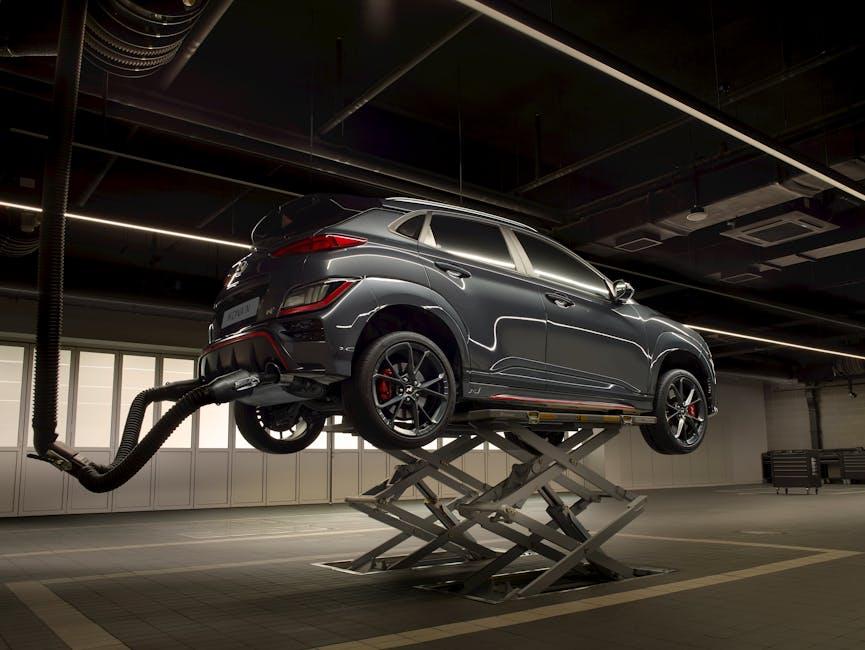Beneath the smooth glide of every vehicle lies a complex network of components working tirelessly to absorb shocks, maintain balance, and ensure safety—the suspension system. Often overlooked until something goes wrong, the suspension quietly shoulders the responsibility of comfort and control, transforming every bump and turn into a seamless experience. Yet, like any intricate machinery, it demands attention and care. Regular suspension inspections are more than just routine maintenance; they are a vital practice that safeguards performance, extends vehicle lifespan, and, most importantly, protects lives on the road. In this article, we delve into why keeping a close eye on your suspension isn’t merely advisable—it’s indispensable.
Table of Contents
- The Crucial Role of Suspension Systems in Vehicle Safety
- Recognizing Early Signs of Suspension Wear and Damage
- How Regular Inspections Enhance Driving Comfort and Control
- The Impact of Suspension Maintenance on Tire Longevity
- Step-by-Step Guide to Conducting an Effective Suspension Check
- Expert Tips for Choosing the Right Suspension Service Provider
- Q&A
- Wrapping Up

The Crucial Role of Suspension Systems in Vehicle Safety
Suspension systems are the unsung heroes of driving, quietly working to keep your vehicle stable and responsive, especially when navigating unpredictable road conditions. They absorb shocks from potholes, bumps, and uneven terrain, allowing your tires to maintain consistent contact with the road. Without a well-maintained suspension, your car’s handling can become sluggish and unpredictable, increasing the risk of accidents during sudden maneuvers or emergency stops. Regular inspections help identify wear and tear on components such as shock absorbers, struts, and springs, which are crucial for maintaining this finely tuned balance of comfort and control.
Neglecting suspension maintenance impacts more than ride comfort—it can jeopardize your safety and lead to costly repairs. Key indicators you shouldn’t ignore include uneven tire wear, excessive bouncing, or drifting during turns. Here are some essential points to consider regularly:
- Shock Absorbers: Ensure they dampen road impacts effectively to prevent vehicle instability.
- Springs: Check for cracks or sagging that reduce load-bearing capacity.
- Ball Joints and Bushings: Examine for looseness or damage that could affect steering precision.
| Suspension Component | Common Issue | Safety Impact |
|---|---|---|
| Shock Absorbers | Leaking fluid | Reduced road grip |
| Springs | Sagging or broken coils | Uneven vehicle stance |
| Ball Joints | Excessive play or wear | Loss of steering control |

Recognizing Early Signs of Suspension Wear and Damage
Early detection of suspension issues can save you from costly repairs and ensure a smooth driving experience. Watch for subtle changes such as unusual noises like clunks or squeaks when driving over bumps, which often indicate worn bushings or shocks. Another common sign is uneven tire wear, caused by misaligned suspension components or failing shocks failing to keep tires properly grounded. Additionally, a vehicle that pulls to one side or feels unstable during turns suggests potential issues with struts or ball joints.
- Vibrations felt through the steering wheel
- Bouncing or excessive sway on rough roads
- Visible leaks of hydraulic fluid near shocks or struts
- Lowered ride height on one side of the vehicle
| Symptom | Potential Cause | Recommended Action |
|---|---|---|
| Clunking noises | Worn control arm bushings | Inspect and replace bushings |
| Uneven tire wear | Misaligned suspension | Perform wheel alignment |
| Vehicle pulls to one side | Damaged tie rods | Check tie rods and replace if necessary |

How Regular Inspections Enhance Driving Comfort and Control
Ensuring your suspension system is in top condition directly impacts how smoothly and safely your vehicle handles daily driving challenges. Regular inspections help identify worn-out or damaged components such as shocks, struts, and bushings before they cause discomfort or safety hazards. When your suspension is functioning optimally, you experience a smoother ride, better shock absorption, and enhanced stability, making each journey more comfortable and controlled. Inspecting these parts regularly can prevent uneven tire wear and reduce road noise, creating a quieter, more enjoyable driving environment.
Moreover, routine suspension checks allow you to catch subtle alignment issues and structural weaknesses early. This proactive approach not only extends the lifespan of your suspension but also ensures that your steering remains precise and responsive. The following list highlights key benefits that regular suspension inspections provide:
- Improved handling and vehicle control
- Greater safety through sustained braking performance
- Enhanced tire longevity due to even wear patterns
- Reduced repair costs by preventing extensive damage

The Impact of Suspension Maintenance on Tire Longevity
Proper suspension maintenance plays a critical role in extending the lifespan of your tires by ensuring even wear patterns. When suspension components such as shocks, struts, and bushings are worn or damaged, they fail to absorb road impacts effectively, causing tires to experience irregular contact with the road surface. This leads to uneven tread wear, which not only shortens tire life but also impacts vehicle handling and safety. Maintaining suspension components ensures that tires maintain optimal traction and alignment, ultimately preserving their structural integrity over time.
- Enhanced tire grip: Well-maintained suspension keeps tires firmly in contact with the road.
- Reduced tread deformation: Proper shocks and struts prevent tire sidewall stress.
- Improved alignment consistency: Maintains proper wheel angles reducing edge wear.
| Suspension Issue | Tire Effect | Recommended Action |
|---|---|---|
| Worn Shock Absorbers | Patchy wear on tread | Replace shocks every 50,000 miles |
| Loose Bushings | Uneven sidewall bulging | Inspect bushings yearly |
| Misaligned Wheels | Rapid edge wear | Align wheels after suspension work |

Step-by-Step Guide to Conducting an Effective Suspension Check
Begin by visually inspecting the suspension components for any signs of wear or damage. Focus on the shock absorbers, springs, and bushings, looking for cracks, leaks, or rust. Use a bright flashlight to spot hidden issues, and gently rock the vehicle to notice any unusual noises or excessive movement. Pay special attention to the mounting points and ensure bolts and fasteners remain tight. Completing this initial assessment helps identify problems before they escalate into costly repairs.
Next, perform simple manual tests to confirm the suspension’s responsiveness. Carefully press down on each corner of the vehicle to check for rebound time; a healthy suspension should bounce back smoothly without lingering. Additionally, test the alignment by driving over a flat surface and observing if the car pulls to one side. Keep the following checklist handy for your convenience:
- Inspect shock absorbers for leaks
- Check springs for cracks or deformation
- Evaluate bushings and mounts for wear
- Ensure suspension bolts are securely fastened
- Test rebound by pressing down the vehicle corners

Expert Tips for Choosing the Right Suspension Service Provider
Choosing a reliable service provider for suspension maintenance means prioritizing expertise and trustworthiness. Look for providers with certified technicians who specialize in suspension systems, as this ensures your vehicle receives the care it deserves. Transparency in communication is essential; a good provider will clearly explain the issues found during inspection and recommend appropriate solutions without pushing unnecessary services.
Consider these important factors when selecting your suspension specialist:
- Customer reviews and testimonials: Genuine feedback reveals the level of satisfaction and service quality.
- Diagnostic technology: Modern tools help pinpoint problems quickly and accurately.
- Warranties and guarantees: Reliable providers stand behind their repairs with solid coverage options.
| Key Attribute | Why It Matters |
|---|---|
| Certification | Ensures technician skill and adherence to industry standards |
| Diagnostic Tools | Helps identify exact suspension faults early |
| Customer Support | Provides clear guidance and honest advice |
Q&A
Q&A: The Importance of Regular Suspension Inspections
Q1: Why is the suspension system crucial for a vehicle?
A1: The suspension system acts like the vehicle’s backbone, absorbing shocks from the road and keeping tires firmly in contact with the surface. This ensures not only a smooth ride but also critical control and stability, especially in turns or on uneven terrain.
Q2: What are the main components checked during a suspension inspection?
A2: Key parts include shock absorbers or struts, springs, control arms, bushings, and ball joints. Inspectors look for wear, leaks, cracks, or any signs of damage that could compromise performance.
Q3: How often should I have my suspension inspected?
A3: While recommendations vary, it’s generally wise to have a suspension inspection every 12,000 to 15,000 miles or at least once a year. If you frequently drive on rough roads or notice handling issues, more frequent checks are advisable.
Q4: What are the warning signs that indicate a suspension problem?
A4: Common clues include unusual noises like clunking or squeaking, a bumpy or unstable ride, uneven tire wear, and the car pulling to one side. If your vehicle noses down during braking or sways excessively in turns, your suspension likely needs attention.
Q5: Can neglecting suspension inspections affect safety?
A5: Absolutely. A compromised suspension can reduce braking efficiency, impair steering response, and increase the risk of losing control—potentially leading to accidents. Regular inspections help catch issues early and keep your vehicle safe on the road.
Q6: Does suspension maintenance impact other vehicle parts?
A6: Yes, a well-maintained suspension prevents uneven tire wear and reduces strain on the steering and braking systems. Ignoring suspension problems can lead to costly damage elsewhere in your vehicle.
Q7: Is suspension inspection costly or complicated?
A7: Inspections themselves are typically straightforward and affordable when done by a professional. The cost of repairing or replacing worn parts is minimal compared to the expenses and risks of driving with a faulty suspension.
Q8: What’s the best approach to suspension care?
A8: Combine regular inspections with attentive driving habits—avoid potholes, don’t overload your vehicle, and address any unusual symptoms promptly. Proactive care ensures the suspension performs optimally, extending vehicle life and enhancing safety.
By understanding and prioritizing regular suspension inspections, drivers can navigate roads confidently—knowing their vehicles are ready to absorb the bumps, twists, and turns ahead.
Wrapping Up
In the intricate dance between driver and road, the suspension system plays a silent yet vital role, cushioning every bump and curve with precision. Regular suspension inspections are not merely a routine check—they are a commitment to safety, comfort, and vehicle longevity. By giving this often-overlooked component the attention it deserves, you ensure every journey is smoother, steadier, and safer. After all, the road may be unpredictable, but your suspension doesn’t have to be.

